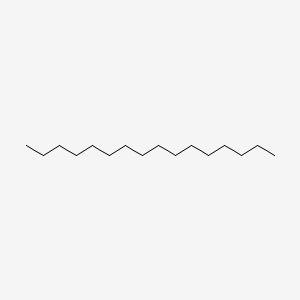| MeSH term | MeSH ID | Detail |
|---|---|---|
| Lupus Erythematosus, Systemic | D008180 | 43 associated lipids |
| Body Weight | D001835 | 333 associated lipids |
| Coronary Disease | D003327 | 70 associated lipids |
| Peritonitis | D010538 | 38 associated lipids |
| Hyperplasia | D006965 | 34 associated lipids |
| Glomerulonephritis | D005921 | 35 associated lipids |
| Encephalomyelitis, Autoimmune, Experimental | D004681 | 26 associated lipids |
| Keratosis | D007642 | 9 associated lipids |
| Serratia Infections | D016868 | 2 associated lipids |
Hexadecane
Hexadecane is a lipid of Fatty Acyls (FA) class. The involved functions are known as Analyte. The related lipids are Fatty Acids and palmitoleic acid.
Cross Reference
Introduction
To understand associated biological information of Hexadecane, we collected biological information of abnormalities, associated pathways, cellular/molecular locations, biological functions, related genes/proteins, lipids and common seen animal/experimental models with organized paragraphs from literatures.
What diseases are associated with Hexadecane?
There are no associated biomedical information in the current reference collection.
Possible diseases from mapped MeSH terms on references
We collected disease MeSH terms mapped to the references associated with Hexadecane
PubChem Associated disorders and diseases
What pathways are associated with Hexadecane
There are no associated biomedical information in the current reference collection.
PubChem Biomolecular Interactions and Pathways
Link to PubChem Biomolecular Interactions and PathwaysWhat cellular locations are associated with Hexadecane?
There are no associated biomedical information in the current reference collection.
What functions are associated with Hexadecane?
Related references are published most in these journals:
| Function | Cross reference | Weighted score | Related literatures |
|---|
What lipids are associated with Hexadecane?
Related references are published most in these journals:
| Lipid concept | Cross reference | Weighted score | Related literatures |
|---|
What genes are associated with Hexadecane?
There are no associated biomedical information in the current reference collection.
What common seen animal models are associated with Hexadecane?
There are no associated biomedical information in the current reference collection.
NCBI Entrez Crosslinks
All references with Hexadecane
Download all related citations| Authors | Title | Published | Journal | PubMed Link |
|---|---|---|---|---|
| Brown TN | Predicting hexadecane-air equilibrium partition coefficients (L) using a group contribution approach constructed from high quality data. | 2014 | SAR QSAR Environ Res | pmid:24286186 |
| Mounier J et al. | The marine bacterium Marinobacter hydrocarbonoclasticus SP17 degrades a wide range of lipids and hydrocarbons through the formation of oleolytic biofilms with distinct gene expression profiles. | 2014 | FEMS Microbiol. Ecol. | pmid:25318592 |
| Chakraborty H et al. | pH Alters PEG-mediated fusion of phosphatidylethanolamine-containing vesicles. | 2014 | Biophys. J. | pmid:25229141 |
| Nogina TM et al. | [The ability of actinobacteria to assimilate n-alkanes under nitrate-reducing conditions]. | 2013 Sep-Oct | Mikrobiol. Z. | pmid:24479308 |
| Pirog TP et al. | [Effect of growth factors and some microelements on biosurfactant synthesis of Acinetobacter calcoaceticus IMV B-7241]. | 2013 Sep-Oct | Mikrobiol. Z. | pmid:24479309 |
| Pirog TP et al. | [Effect of Cu2+ on synthesis of biosurfactants of Acinetobacter calcoaceticus IMV B-7241 and Rhodococcus erythropolis IMV Ac-5017]. | 2013 Jan-Feb | Mikrobiol. Z. | pmid:23516834 |
| Sawai Y et al. | Photoinduced underwater superoleophobicity of TiO2 thin films. | 2013 | Langmuir | pmid:23701360 |
| Sakuradani E et al. | Subterminal oxidation of n-alkanes in achlorophyllous alga Prototheca sp. | 2013 | J. Biosci. Bioeng. | pmid:23651808 |
| Cheng L et al. | DNA-SIP reveals that Syntrophaceae play an important role in methanogenic hexadecane degradation. | 2013 | PLoS ONE | pmid:23840866 |
| Saikia RR and Deka S | Removal of hydrocarbon from refinery tank bottom sludge employing microbial culture. | 2013 | Environ Sci Pollut Res Int | pmid:23764986 |
| Masheder B et al. | Transparent and hard zirconia-based hybrid coatings with excellent dynamic/thermoresponsive oleophobicity, thermal durability, and hydrolytic stability. | 2013 | ACS Appl Mater Interfaces | pmid:23848181 |
| Park HB et al. | One shot-two pathogens blocked: exposure of Arabidopsis to hexadecane, a long chain volatile organic compound, confers induced resistance against both Pectobacterium carotovorum and Pseudomonas syringae. | 2013 | Plant Signal Behav | pmid:23603940 |
| Cheng L et al. | Novel bacterial groups dominate in a thermophilic methanogenic hexadecane-degrading consortium. | 2013 | FEMS Microbiol. Ecol. | pmid:23621116 |
| Abin-Fuentes A et al. | Exploring the mechanism of biocatalyst inhibition in microbial desulfurization. | 2013 | Appl. Environ. Microbiol. | pmid:24096431 |
| Jing D and Bhushan B | Boundary slip of superoleophilic, oleophobic, and superoleophobic surfaces immersed in deionized water, hexadecane, and ethylene glycol. | 2013 | Langmuir | pmid:24168076 |
| Lukacova V et al. | Structural determinants of drug partitioning in surrogates of phosphatidylcholine bilayer strata. | 2013 | Mol. Pharm. | pmid:23964749 |
| Pęziak D et al. | Bioavailability of hydrocarbons to bacterial consortia during Triton X-100 mediated biodegradation in aqueous media. | 2013 | Acta Biochim. Pol. | pmid:24432333 |
| Natesan S et al. | Structural determinants of drug partitioning in n-hexadecane/water system. | 2013 | J Chem Inf Model | pmid:23641957 |
| Hamamura N et al. | Effects of petroleum mixture types on soil bacterial population dynamics associated with the biodegradation of hydrocarbons in soil environments. | 2013 | FEMS Microbiol. Ecol. | pmid:23488682 |
| Leptihn S et al. | Constructing droplet interface bilayers from the contact of aqueous droplets in oil. | 2013 | Nat Protoc | pmid:23640169 |
